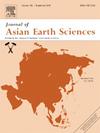Active tectonics and kinematic architecture of intraplate strike-slip fault: Savrun fault zone, SE Türkiye
IF 2.7
3区 地球科学
Q2 GEOSCIENCES, MULTIDISCIPLINARY
引用次数: 0
Abstract
Türkiye is a unique country whose deformation pattern has been formulated in terms of three main plates Eurasia, Africa, Arabia and microplate Anatolian that are actively moving in recent time. This variety creates a giant fault network defining the plate boundaries and intraplate faults. Savrun Fault Zone (SFZ) is one of the intraplate strike-slip faults near west of the 2023 earthquakes area and many controversies have arisen about its activeness. In this study, it is investigated and reported on the geometric, structural, and kinematic characteristics of the SFZ based on field measurements of fault-slip data. At least two different deformation phases have been recognized in the geological evolution of the SFZ; older NNE-SSW compressional tectonic up to Middle Pliocene and the youngest strike-slip regime created by N-S compression and E-W extensional direction. According to the results, SFZ is a reactivated reverse fault and its the present-day configuration is an active sinistral strike-slip architecture comprising three segments (north, middle and east) and two contractional stepovers reflecting strong geomorphic indicators marked by strike parallel fault valley.
板块内走滑断层的活动构造与运动学构造:甘肃东南萨夫润断裂带
本文章由计算机程序翻译,如有差异,请以英文原文为准。
求助全文
约1分钟内获得全文
求助全文
来源期刊

Journal of Asian Earth Sciences
地学-地球科学综合
CiteScore
5.90
自引率
10.00%
发文量
324
审稿时长
71 days
期刊介绍:
Journal of Asian Earth Sciences has an open access mirror journal Journal of Asian Earth Sciences: X, sharing the same aims and scope, editorial team, submission system and rigorous peer review.
The Journal of Asian Earth Sciences is an international interdisciplinary journal devoted to all aspects of research related to the solid Earth Sciences of Asia. The Journal publishes high quality, peer-reviewed scientific papers on the regional geology, tectonics, geochemistry and geophysics of Asia. It will be devoted primarily to research papers but short communications relating to new developments of broad interest, reviews and book reviews will also be included. Papers must have international appeal and should present work of more than local significance.
The scope includes deep processes of the Asian continent and its adjacent oceans; seismology and earthquakes; orogeny, magmatism, metamorphism and volcanism; growth, deformation and destruction of the Asian crust; crust-mantle interaction; evolution of life (early life, biostratigraphy, biogeography and mass-extinction); fluids, fluxes and reservoirs of mineral and energy resources; surface processes (weathering, erosion, transport and deposition of sediments) and resulting geomorphology; and the response of the Earth to global climate change as viewed within the Asian continent and surrounding oceans.
 求助内容:
求助内容: 应助结果提醒方式:
应助结果提醒方式:


